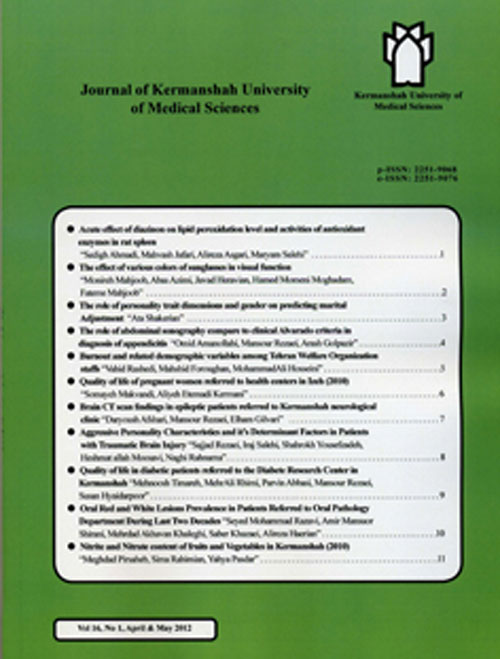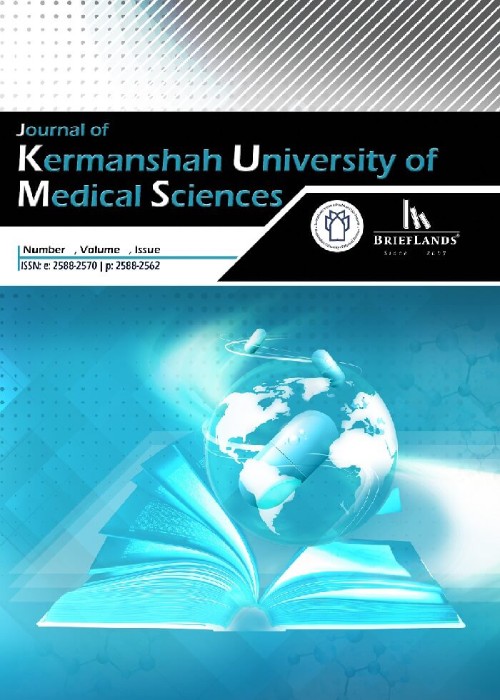فهرست مطالب

Journal of Kermanshah University of Medical Sciences
Volume:21 Issue: 1, 2017
- تاریخ انتشار: 1396/03/11
- تعداد عناوین: 9
-
-
Pages 1-6IntroductionAlthough soy-based foods have been reported to affect serum levels of inflammatory biomarkers, there was no study examining the effects of soybean flour-enriched bread in diabetic patients. The aim of this study was to determine the effects of consumption of soybean flour-enriched bread on inflammatory markers in type 2 diabetic women.MethodsThis randomized, cross-over, controlled clinical trial recruited 30 type 2 diabetic women. After a 2-week run-in period, participants were randomly assigned to either intervention (soy bread) or control groups (habitual diet). Participants in the intervention group were asked to consume 120 g of soybean flour-enriched bread instead of the same amount of usual bread intake or other cereals. Participants in the control group were asked to remain on the habitual diet. After a four-week washout period, the participants were crossed over for another six weeks.ResultsMean (±SD) age, weight and BMI of the subjects was 45.7±3.8 years, 73.8±10.7 and 29.5±3.9 kg/m2, respectively. We found no significant effect of soybean flour-enriched bread on high sensitive C-reactive protein (change difference: -0.04, P=0.6), Tumor Necrosis Factor-alpha (change difference: -14.2, P=0.27), interleukin 6 (change difference: -0.06, P=0.15) and Soluble Vascular Cell Adhesion Molecule-1 among women in the intervention group compared with the control group. No significant effects were observed in serum levels of sVCAM1 after consumption of soybean flour-enriched bread.ConclusionSoybean flour-enriched bread consumption had no significant effects on inflammatory markers.Keywords: Soybeans, inflammation, diabetes
-
Pages 7-15IntroductionFrom among various cognitive deficits, deficits in executive processes have an effective role in limiting the patients ability to retain, acquire, and re-learn the skills necessary for real-life performance. Thus, the present study aimed to compare the executive function of patients with schizophrenia, acute/chronic type I disorder, and the healthy group.MethodsThe present research was an analytical-comparative study. The statistical population consisted of all the outpatients and inpatients with acute/chronic schizophrenia and acute/chronic type I disorder (manic episode) visiting Shafa Psychiatric Hospital, Rasht, Iran. Using convenience sampling, 60 male subjects aging 18-49 years old were selected in 2014-2015. They were matched for the variables of sex, age, and education level. The Wisconsin Card Sorting Test, Continuous Performance Test, and Ravens Progressive Matrices were administered, and the data were analyzed using MANOVA and Tukey post-hoc test.ResultsA significant difference was observed between the acute/chronic schizophrenia group, acute/chronic type I disorder (manic episode), and healthy group on the two tests. Patients with schizophrenia had a weaker executive function and attention deficit compared to those with type I disorder and the healthy group (P£0.05).ConclusionBoth schizophrenia and type I disorder patients show deficits in executive function and attention. However, the former group manifests higher impairment in cognitive activities, concept formation, cognitive flexibility, and attention deficit.Keywords: Schizophrenia_type I disorder_executive function_Wisconsin Card Sorting Test_Continuous Performance Test
-
Pages 16-22IntroductionPolycystic ovary syndrome is characterized by ovulatory dysfunction and hyperandrogenism. Although insulin resistance is not a diagnostic criterion for polycystic ovary syndrome, it has an important role in the development of the clinical presentation in a majority of patients with this syndrome. Many studies have examined the relationship of epicardial fat thickness with insulin resistance and cardiovascular complications. This study aimed to determine the relationship of epicardial fat thickness with polycystic ovary syndrome and insulin resistance.MethodsThis cross-sectional study recruited women with polycystic ovary syndrome presenting to endocrinology clinic in Kermanshah city. Sixty-four patients with polycystic ovary syndrome, without underlying diseases, were divided into two groups of 32 according to the HOMA-IR index as insulin resistant and insulin sensitive. Their epicardial fat thickness was measured by transtorasic echocardiography.ResultsThe results of this study suggest that epicardial fat thickness has a direct and significant relationship with insulin resistance and BMI in patients with polycystic ovary syndrome.ConclusionAccording to the results, the increase in the thickness of epicardial fat is independent of the disease in patients with polycystic ovary syndrome. The cause of the increased thickness is the metabolic syndrome and increased insulin resistance in these patients.Keywords: polycystic ovary syndrome, insulin resistance, epicardial fat thickness
-
Pages 23-26IntroductionRice tablets (aluminum phosphide) are used to fight insects and pests in the grain storage spaces. This tablet produces phosphine gas which is a toxic substance for mitochondria. New measures have merely been recommended to save the lives of poisoned patients at referral clinical toxicology centers. The purpose of this study is to compare the prognosis of the new and old protocols in rice tablet poisoning.MethodsThis clinical trial recruited 126 eligible patients poisoned with rice tablets presenting to the Imam Khomeini Hospital in Kermanshah in 2013, who were assigned into two groups of the new (magnesium sulfate) and old protocols. Data were analyzed using statistical tests in SPSS software version 21.ResultsThe age of the patients was between 12 and 76 years, with a mean of 30.78 years and a standard deviation of 12.88 years. Among the patients, 77 (58.3%) were male and 55 (41.7%) were female. 43.9%/59.1%, 16.7%/31.8%, 9.1%/25.8%, and 40.9%/42.4% subjects suffered from cardiac, renal, hepatic and pulmonary complications, in new and old treatment groups respectively. Renal (P=0.046) and hepatic (P=0.12%) complications were significantly lower in patients under the new treatment. Furthermore, the mortality rate in the new protocol was significantly lower (P=0.036).ConclusionIn this study, the new protocol was better able than the old one to reduce morbidity and mortality rates. Therefore, the use of this new treatment protocol can be beneficial in the treatment of patients poisoned with rice tablets.Keywords: Aluminum Phosphate, Magnesium Sulfate, Poisoning
-
Comparison of cytological parameters of exfoliated buccal mucosal cells in different temperament groupsPages 27-31IntroductionTemperament (Mizaj) forms the basic concept of Iranian traditional medicine (ITM), and greatly influences the diagnosis and treatment of diseases, as well as maintains the ideal healthy state of an individual. In particular, temperament is presumed to affect the morphological, physiological, and psychological features of a person; however, its influence on biological features remains unclear in practical ITM. This study aimed to evaluate the association between the temperament and the cytological features of buccal mucosa in healthy people.MethodsThe study sample included 75 healthy individuals from Fars province, southern Iran. The temperament was determined using a self-reported temperament identification scale. Based on the questionnaire, volunteers were classified in nine temperaments including one equilibrium, four simple temperaments (warm, cold, moist, and dry,) and four combined temperaments (warmmoist, warmdry, coldmoist, colddry). Smears collected from the buccal mucosa of participants were analyzed for biomarkers of DNA damage, cytokinetic defects, proliferative potential, and cell death using micronucleus (MN) assay. Students t-test or MannWhitney U test was applied to identify the differences between groups.ResultsDNA damage (nuclear buds) and cell death biomarkers (condensed chromatin, karyorrhexic, pyknotic, and karyolitic cells) reported significant differences between certain temperament groups.ConclusionsThe present study reported that the aforementioned cytological parameters could be affected by the temperament; however, more studies with greater sample sizes are warranted.Keywords: temperament, buccal cells, micronucleus test, cytological parameters
-
Pages 32-36IntroductionIt is important to have data on human papillomavirus (HPV) from different geographical regions of Iran for health policymakers to make decisions on national programs of HPV vaccination. Because no study was found on HPV genotyping in Kermanshah Province, this study appeared necessary.MethodsFifty-three paraffin-embedded cervical tissue samples were collected. All samples were evaluated by polymerase chain reaction (PCR) or nested-polymerase chain reaction assays with specific primers designed for L1 gene. Positive samples were subjected to sequence and phylogenic tree analysis.ResultsThirty-one out of 53 samples (58.5%) were found to be HPV positive. Prominent HPV genotype was HPV16 followed by HPV6, 31 and 53. Based on the histology of cervicitis, only HPV16 was found both in cervicitis and adenocarcinoma while HPV6 and 16 were found in cervical intraepithelial neoplasia I, and HPV6 and 53 were found in cervical intraepithelial neoplasia II. HPV16 and 31 were also found in squamous cell carcinoma.DiscussionFindings from this study support a strong correlation of HPV16 as a leading cause of cervical cancer in this region. It appears that HPV vaccines could drastically reduce the incidence of cervical cancer.Keywords: Cervical Cancer, Papillomavirus, Genotype
-
Pages 37-41IntroductionAnxiety is a subjective response that occurs when a person experiences a threat to their well-being. Each new academic year brings challenges (i.e., anxiety) and new situations for the students, which may cause anxiety in a majority of the students, especially for those enrolled in medical or paramedical courses, due to the stressful working environment. Female students are more prone to anxiety disorders. Anxiety may impair learning and performance. Hence, this study aimed to evaluate the anxiety level among nursing students of Kirkuk University, Iraq, at the commencement of their new academic year.MethodsIn this descriptive study, data were collected by Becks anxiety inventory scale. A stratified random sampling was performed, which included both male and female students (100 students), with 25 students from each stage. The data were analyzed by SPSS 22 software using descriptive methods.ResultsThe findings of this study revealed that the second and the third stages reported higher anxiety levels (64 and 40%, respectively) than the first and fourth stages (32 and 35%, respectively). The female students reported higher anxiety levels (44% for mild level, 50% for moderate level, and 2.38% for severe level) than the male students (37.5% for mild level, 31.25% for moderate level, and no frequency for the severe level).ConclusionsBased on the study results, we conclude that high anxiety levels were reported by the second and third stages, and that these levels were higher in females. Further studies are recommended to explore the anxiety factors in students and to find appropriate measures to reduce their anxiety.Keywords: anxiety levels, nursing students, new year studying
-
Pages 42-47IntroductionSkeletal abnormalities affect physical efficiency and fitness during daily life and sports activities. This research was carried out to evaluate different spinal abnormalities of male junior high school students.MethodsThe study population comprised of male junior high school students in Kermanshah, Iran, among whom 390 students were selected by cluster sampling. The required data were collected by spinal examination using New York test, Thomas test, Adams test, and flexible ruler, and the data of somatotypes were collected by Sheldon method. The obtained data were analyzed by descriptive statistics.ResultsThe results showed that 18.93% of students were in normal physical condition, and 81.03% of them suffered from at least one kind of abnormality. Among spinal abnormalities, the sway back and flat back abnormalities (2.56%) were found to have the lowest prevalence and right shoulder dropping (65.64%) and hyperlordosis (38.46%) were found to have the highest prevalence. Regarding their body type, 61.8% of the samples were ectomorphic, 21.79% were endomorphic, and 16.41% were mesomorphic.ConclusionThe findings showed a high incidence of abnormalities among students. Although this level of prevalence is less than those of some other societies, it is obviously indicative of a lack of sufficient attention to the physical health of students.Keywords: Abnormality, spine, male students
-
Pages 48-50The present study aimed to examine the effectiveness of integrating cognitive-behavioral therapy (CBT) and mindfulness-based cognitive therapy (MBCT) on major depressive disorder and suicidal thoughts in a depressive case suffering from suicidal thoughts. This research was an experimental single-case study with a before-and-after design and six-month follow-up. Data were collected using a clinical interview, the Beck Depressive Inventory, and the Beck Scale for Suicidal Ideation. Results indicated the effectiveness of the intervention in decreasing the symptoms of depression and suicidal thoughts, with 64% and 67% improvements in depression and suicidal thoughts, respectively. These effects were maintained during the follow-up period.Keywords: Major depression, suicide, cognitive-behavioral therapy, mindfulness


